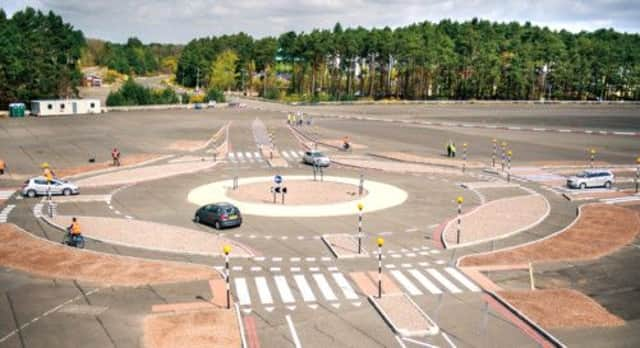Scots to study Dutch roundabouts for safer cycling


The so-called Dutch roundabouts have separate slip lanes for cyclists to ensure that they do not have to compete for space with cars, buses and lorries.
Cycling campaigners report that more than two-thirds of accidents occur at junctions, as bikes are forced into conflict with vehicles.
Advertisement
Hide AdAdvertisement
Hide AdYesterday Keith Brown, Scotland’s transport minister who is among those travelling to Amsterdam, said he welcomed the opportunity to learn from countries that have more evolved cycling strategies. He said he would also be watching developments in London, where last week Transport for London announced it was investing £2 million in a project to introduce Dutch roundabouts in the city.
“We have an ambitious vision to promote cycling but there is no need to re-invent the wheel and I am keen that we learn from the experiences of our neighbours”, Brown told Scotland on Sunday.
“I am very much looking forward to finding out about the different approaches taken in the Netherlands regarding cycling infrastructure and other softer measures.
“It will also be interesting to see how the Transport for London research into junction and roundabout layouts develops.
“I am supportive of any improvements that Scottish planning authorities and local roads authorities can implement to make our roads a safer place to cycle.”
Last year, cycling deaths hit a five-year high, with 122 killed on Britain’s roads, including 14 in London and three in Edinburgh.
The increase comes as cycling as a means of transport has grown in popularity among people of all ages, and campaigners say it highlights inadequate safety measures for those on two wheels.
Dutch roundabouts have proved popular in the Netherlands because they allow cyclists the safe option of a separate lane on the approach to a roundabout junction where they are most vulnerable.
Advertisement
Hide AdAdvertisement
Hide AdIan Aitken, chief executive of Cycling Scotland, the national bike promotion body, said he was keen to see them introduced in Scotland.
“The Dutch-style roundabouts that are now being implemented in London would be very welcome in Scotland because they make conditions safer for cyclists at junctions, which is where 68 per cent of all accidents involving cyclists occur,” he said.
“These roundabouts not only give cyclists priority at a junction, they are also more effective at encouraging motorists to slow down, as they only have a single lane for entry and exit.”
In recent years, cities across the UK have struggled to ensure that 1 or 2 per cent of journeys are travelled by cycling.
Politicians and transport officials on the Holland trip will examine how the authorities in Holland achieve journey rates of 60 per cent and more. In Edinburgh, the figure is 8 per cent, with a target by the city council of 15 per cent.
Sarah McIntosh, a lecturer in urban planning at Heriot-Watt University, said increasing the number of journeys taken by bike would make cycling safer.
“Having cycled in the Netherlands, I can say it is a completely different attitude. Everybody knows at least somebody who cycles, and so there is a greater degree of care taken. They feel it could be their children, for instance, and are far more aware,” she said. “The theory is that once we start to see a greater proportion of road users cycling, then drivers will become more aware.”
New traffic measures would improve safety, she added, but transports officials in Scotland may struggle to adapt certain measures.
Advertisement
Hide AdAdvertisement
Hide Ad“From a planning perspective it seems a good idea to have segregated lanes,” she said. “The fact is, however, we never planned for this when we were building roads in Scotland – in contrast to in Europe, where they factored in cycling.
“Cycling lanes have improved over time, but there is little capacity, and many cycle lanes and roads are very narrow.”
In Edinburgh, which co-hosted a cycling conference with the Dutch embassy last year, the city council has increased spending on cycling and said it is keen to adopt a range of road safety measures, including new roundabouts.
However, it has previously come under fire from campaigners over the design of new roundabouts on Leith Walk, which were described as a “cyclist blender” by one academic, referring to bikes being forced to cross vehicle traffic.
In addition, there have been complaints from cyclists about the city council’s much hyped £650,000 Quality Bike Corridor, running 3km from George IV Bridge in the city centre to Edinburgh University’s King’s Buildings Campus in south Edinburgh.
Commercial and privately owned vehicles are allowed to park on sections of the route, which forces cyclists out onto the main road.
Lothian Green MSP Alison Johnstone has labelled the “part-time” route as “disappointing” for cyclists.
Jim Orr, Edinburgh’s deputy transport leader, who is accompanying Keith Brown on the Dutch trip, said round-abouts were a key issue to be addressed.
Advertisement
Hide AdAdvertisement
Hide Ad“We’ll be watching this trial with interest. The planned investment in cycling in London, while less as a proportion of transport spend than Edinburgh, is certainly great news. No matter what city you live in, modern challenges around road safety, air quality, cost of maintenance or efficient transportation can all be addressed by increasing cycling rates.
“Reconfiguring junctions is desirable and effective but can be expensive, and so most cities pursue a suite of options including traffic-calming measures, like 20mph zones, and on-road training, like Bikeability run by Cycling Scotland.
“I’m personally hopeful that once cycling rates in Edinburgh reach our target of 15 per cent (we’re currently around 8 per cent), there will be a step-change in attitudes to cycling. This will fundamentally change the perception of cyclists on our streets, and hopefully create a feeling of safety in numbers.”
Twitter: @RoryReynolds